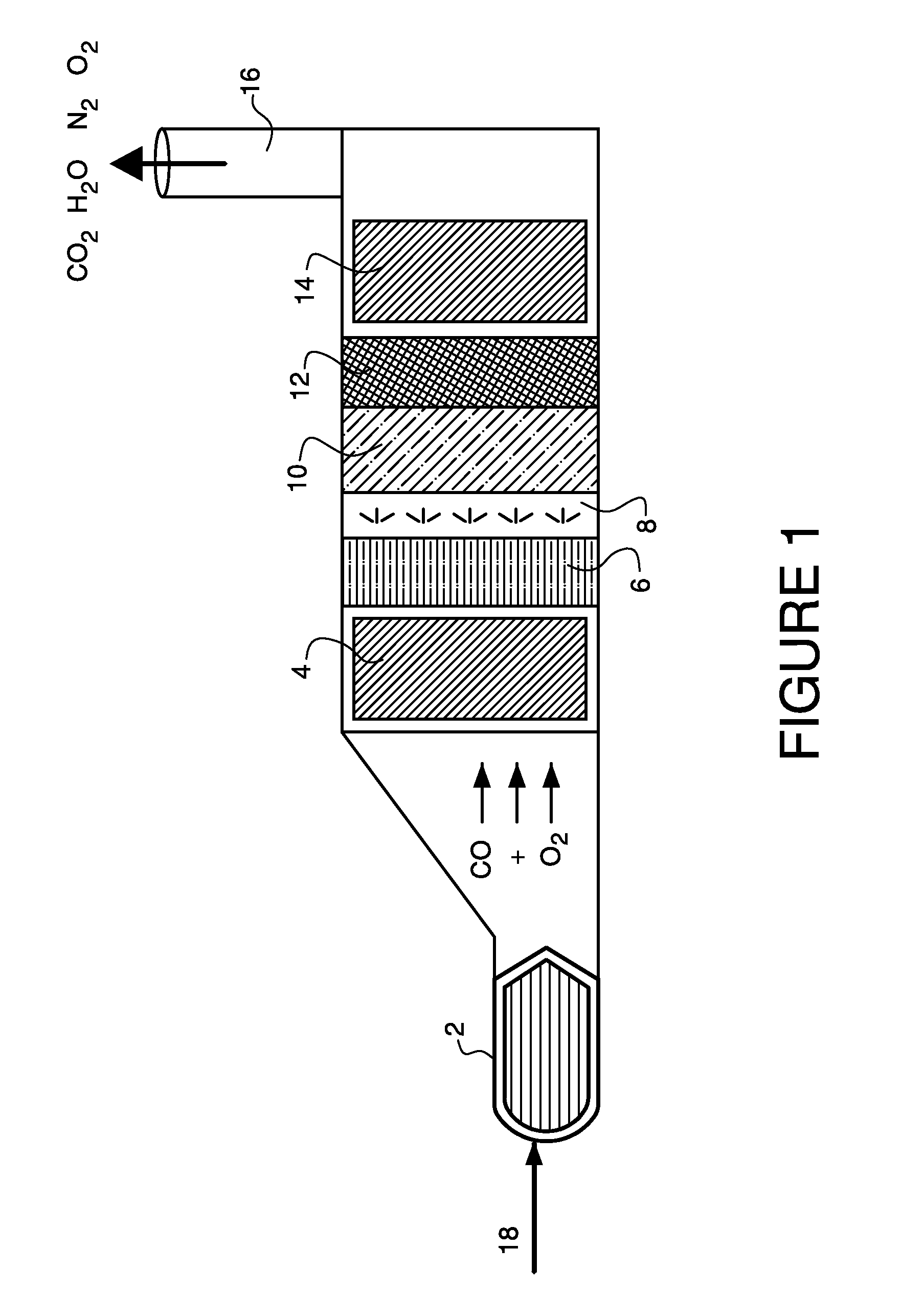Catalysts for dual oxidation of ammonia and carbon monoxide with low to no NOX formation
a technology of ammonia and carbon monoxide, which is applied in the direction of catalyst activation/preparation, metal/metal-oxide/metal-hydroxide catalysts, and combustion gas purification/modification. it can solve the problem of ammonia gas emission into the atmosphere, ammonia gas emission from downstream components and processes, and ammonia slip, so as to increase the cost of catalyst materials and reduce costs.
- Summary
- Abstract
- Description
- Claims
- Application Information
AI Technical Summary
Benefits of technology
Problems solved by technology
Method used
Image
Examples
example 1
[0045]A catalyst of approximate composition 3% MnO2 / 1% K2O / ceria was prepared by starting with 100 g of ceria to which 44.232 ml of 0.5 M KOH was added. The material was dried at 90° C. for 16 hours and then calcined at 540° C. for 2 hours. To this, 17.972 ml of 2.0M Mn(NO3)2 was added. This material was then dried at 90° C. for 16 hours and then calcined at 540° C. for 2 hours. The resulting solid was aged at 500° C. for 16 hours in 10% steam (balance air).
[0046]The catalyst was coated onto a honeycomb monolith using deposition methods known in the art for depositing the catalyst on a foraminous substrate. Methods for depositing the catalyst on the foraminous substrate include, for example, disposing the catalyst in a liquid vehicle to form a slurry and wetting the foraminous substrate with the slurry by dipping the substrate into the slurry, spraying the slurry onto the substrate, and the like.
example 2
[0047]A catalyst of approximate composition 3% MnO2 / 1% MgO / ceria was prepared by starting with 100 g of ceria to which 25.841 ml of 1.0M Mg(NO3)2 was added. The material was dried at 90° C. for 16 hours and then calcined at 540° C. for 2 hours. To this, 17.972 ml of 2.0M Mn(NO3)2 was added. This material was then dried at 90° C. for 16 hours and then calcined at 540° C. for 2 hours. The resulting solid was aged at 500° C. for 16 hours in 10% steam (balance air).
example 3
[0048]A catalyst of approximate composition 3% MnO2 / 1% BaO / ceria was prepared by starting with 100 g of ceria to which 6.793 ml of 1.0M Ba(CH3CO2)2 was added. The material was dried at 90° C. for 16 hours and then calcined at 540° C. for 2 hours. To this, 17.972 ml of 2.0M Mn(NO3)2 was added. This material was then dried at 90° C. for 16 hours and then calcined at 540° C. for 2 hours. The resulting solid was aged at 500° C. for 16 hours in 10% steam (balance air).
PUM
| Property | Measurement | Unit |
|---|---|---|
| temperature | aaaaa | aaaaa |
| temperature | aaaaa | aaaaa |
| weight | aaaaa | aaaaa |
Abstract
Description
Claims
Application Information
 Login to View More
Login to View More - R&D
- Intellectual Property
- Life Sciences
- Materials
- Tech Scout
- Unparalleled Data Quality
- Higher Quality Content
- 60% Fewer Hallucinations
Browse by: Latest US Patents, China's latest patents, Technical Efficacy Thesaurus, Application Domain, Technology Topic, Popular Technical Reports.
© 2025 PatSnap. All rights reserved.Legal|Privacy policy|Modern Slavery Act Transparency Statement|Sitemap|About US| Contact US: help@patsnap.com



